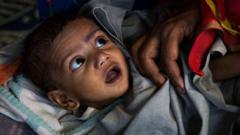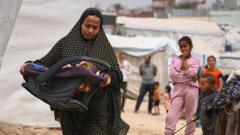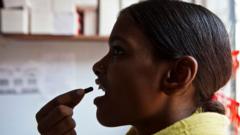A study reveals that social identity, particularly caste discrimination, plays a crucial role in child stunting in India, where 35% of children under five are affected, surpassing rates in Sub-Saharan Africa.
Unveiling the Root Causes of Child Stunting in India

Unveiling the Root Causes of Child Stunting in India
New research highlights the influence of caste on child malnutrition as India battles high stunting rates.
In India, the child stunting crisis has reached alarming proportions, with recent data revealing that 35% of the country’s 137 million children under five are stunted, a significant indicator of malnutrition. A study by Ashwini Deshpande from Ashoka University and Rajesh Ramachandran from Monash University underscores the intricate connection between caste discrimination and child growth. Despite progress, India’s stunting rates surpass many nations in Sub-Saharan Africa, which collectively has an average rate of 33.6%.
Stunting occurs when children are shorter than expected for their age due to nutritional deficiencies, particularly significant during the first 1,000 days of life. This stage is essential for brain development and overall health. While both India and Sub-Saharan Africa face challenges related to malnutrition, including poverty, India's stunting issue is exacerbated by social hierarchies rooted in the caste system.
The economists’ research revealed stark disparities among socially disadvantaged groups, including tribespeople (adivasis) and Dalits, whose children experience significantly higher stunting rates. Conversely, children from non-stigmatized, higher-caste groups face a stunting rate of 27%, markedly lower than that of their marginalized peers who are more susceptible to malnutrition due to limited resources and a less favorable disease environment.
While some argue about genetic predispositions influencing height, the authors emphasize that better access to nutrition and healthier living conditions among higher-caste groups plays a critical role in height discrepancies. Although India has seen some improvements in stunting rates, particularly following health and nutrition interventions over recent years, issues persist for children from poorer families or marginalized groups, underscoring the importance of addressing social identity as a factor in child nutrition.
The study analyzed data from health surveys covering over 195,000 children in India and nearly 203,000 in Sub-Saharan Africa from 2015 and beyond, illustrating how deeply entrenched social systems impact the well-being of future generations in India.
Stunting occurs when children are shorter than expected for their age due to nutritional deficiencies, particularly significant during the first 1,000 days of life. This stage is essential for brain development and overall health. While both India and Sub-Saharan Africa face challenges related to malnutrition, including poverty, India's stunting issue is exacerbated by social hierarchies rooted in the caste system.
The economists’ research revealed stark disparities among socially disadvantaged groups, including tribespeople (adivasis) and Dalits, whose children experience significantly higher stunting rates. Conversely, children from non-stigmatized, higher-caste groups face a stunting rate of 27%, markedly lower than that of their marginalized peers who are more susceptible to malnutrition due to limited resources and a less favorable disease environment.
While some argue about genetic predispositions influencing height, the authors emphasize that better access to nutrition and healthier living conditions among higher-caste groups plays a critical role in height discrepancies. Although India has seen some improvements in stunting rates, particularly following health and nutrition interventions over recent years, issues persist for children from poorer families or marginalized groups, underscoring the importance of addressing social identity as a factor in child nutrition.
The study analyzed data from health surveys covering over 195,000 children in India and nearly 203,000 in Sub-Saharan Africa from 2015 and beyond, illustrating how deeply entrenched social systems impact the well-being of future generations in India.






















